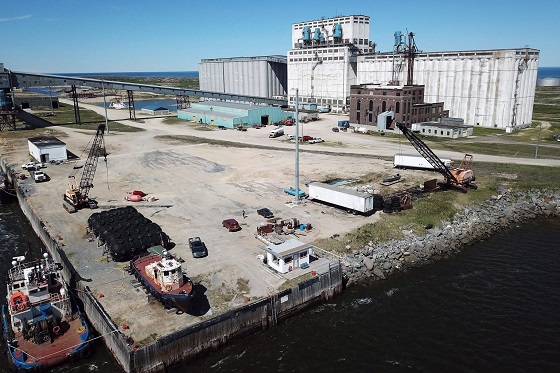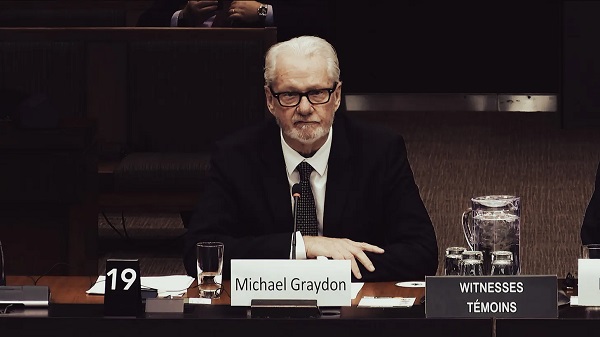Opinion
The Climate-Alarmist Movement Has A Big PR Problem On Its Hands

 From the Daily Caller News Foundation
From the Daily Caller News Foundation
By David Blackmon
The whole “net-zero by 2050” narrative that cranked up in earnest in early 2021 has now become a public relations problem for the climate-alarm movement, according to a senior official at the United Nations.
Chris Stark, the outgoing chief executive of the UN’s Climate Change Committee (CCC), said as reported by the Guardian: “Net zero has definitely become a slogan that I feel occasionally is now unhelpful, because it’s so associated with the campaigns against it. That wasn’t something I expected.”
As seems to always be the case among the globalist sponsors of this government-subsidized rush to saddle the world with unreliable power grids and short-range electric cars, the conversation among the leaders of the movement immediately moves not to perhaps reconsidering the approach to address public concerns, but to rejiggering the narrative. Stark recommends shifting the label and the narrative to more of a focus on investment and how renewables and EVs somehow improve energy security.
“We are talking about cleaning up the economy and making it more productive – you can call that anything you like,” he said.
That would be a neat trick, inventing a narrative about benefits that don’t really exist. But it wouldn’t be the first time it’s been tried.
At last November’s COP 28 conference, UN Secretary General Antonio Guterres floated the term “climate collapse” as a new name for what the climate alarmists have successively called “global warming,” “climate change,” “climate crisis,” and “climate emergency.” Each successive label has been replaced as its cache’ with the public has faded; and apparently the whole “climate emergency” has lost its punch, so another fright narrative must be concocted.
The trouble there, of course, is that the climate is not collapsing. But then again, it isn’t in any sort of an emergency, either, or a crisis.
The climate is always changing, though, so at least the long-abandoned “climate change” label had the ring of truth to it. Maybe let’s go back to that and try to deal with something that is at least a real thing? But, no, that would cut down on the alarm and make it harder for political leaders to enact bad “solutions” and subsidize them with debt combined with skyrocketing utility bills for average citizens.
So, as Stark says, call it anything you want, just so long as it is alarming. Stark’s boss at the UN, Guterres, used the term “global boiling” to describe the current climate situation. So, maybe we change “net-zero by 2050” to “no bubbles by 2050.” That would at least have the advantage of some semblance of consistent thought.
A colleague suggested that we simply change the problematic label to “Stone Age,” since that is where we are heading if the alarmists continue to get their way. She has a point.
The most amazing thing about Stark’s concerns is that anyone is really surprised that “net-zero by 2050” has become a problematic term. How else would officials at the UN and other governments expect the public to react to what has become the umbrella label for a set of authoritarian government actions that have destabilized power grids, caused the cost of living to rise rapidly, reduced consumer choice, and begun to rob citizens in nominally “free” countries of their individual rights?
The central problem today with this climate change narrative is that it has gone on for so long that is has become a bit of a joke with an increasingly aware and skeptical public. And the reason they’re skeptical is not due to any disbelief in science, as the alarmists invariably claim, but because they have seen nothing but bad outcomes and personal deprivations from the alleged solutions being subsidized into existence.
Stark assures us that, “the lifestyle change that goes with this is not enormous at all,” but painful results to date tell another story.
If Stark were truly thoughtful and serious about wanting to deal with the increasing unpopularity of the “net-zero by 2050” construct, he would suggest that everyone take a step back and re-evaluate the nature and effectiveness of the solutions being pushed.
By merely advocating for the concoction of yet another shift in the narrative, a troublesome lack of sincerity is laid bare.
David Blackmon is an energy writer and consultant based in Texas. He spent 40 years in the oil and gas business, where he specialized in public policy and communications.
Health
Tens of thousands are dying on waiting lists following decades of media reluctance to debate healthcare

Better thousands of us die prematurely, apparently, than risk a grownup conversation
About the same time as William Watson’s outstanding book Globalization and the Meaning of Canadian Life was being published in the late 1990s, the newspaper I worked for was sending a journalist to Europe to research a series of articles on how health care systems work in some of those countries.
The Rewrite is a reader-supported publication.
To receive new posts and support my work, consider becoming a free or paid subscriber.
I mention Bill’s book, which was runner-up for a public policy Donner Prize, because it exquisitely details many of the things Canadians believe about themselves that simply aren’t true. Which was the same reason why the Calgary Herald sent its health reporter (yes, there used to be such a thing), Robert Walker, to Europe – to expose its readers to the fact that there are more than two health care systems: our “defining” one and America’s, both of which are extremes. To the best of my knowledge, that remains the only time a Canadian news organization has taken on that task.
In every country examined in Walker’s reports, as is the case with almost every country in the world, public and private health care and insurance systems maintained a peaceful coexistence and the public’s needs were being met. Almost 30 years later, that remains the case. Also almost 30 years later, neither Bill’s book nor the Herald’s reporting has had the slightest impact on the prevailing media narrative in Canada. It remains determined to perpetuate the fear that any move to increase the role of private health providers or even allow doctors to work in both systems (as was proposed this week by Alberta Premier Danielle Smith) is the first step on the slippery slope to “American-style” health care. This line has been successfully used for decades – often hyperbolically and occasionally hysterically – by public monopoly advocates for Canada’s increasingly expensive and difficult to access systems. We have known for 40 years that once Baby Boomers like your faithful servant turned bald and grey that the system would be unsustainable. But that single, terrifying “American-style” slur has halted reform at every turn.
The Tyee responded with a “Danielle Smith’s secret plan to Destroy Public Health Care” column while the Globe and Mail’s Gary Mason, a Boomer, challenged my thesis here by suggesting it was time for open minds because “the reality is, the health care system in Canada is a mess.”
It is. And at least some of the blame – a lot, in my view – belongs at the door of Canadian news organizations that for decades have failed to fully inform readers by making them aware that there are a great many alternatives to just “ours” and “US-style.”
I was reminded of this in a recent Postmedia story concerning the perils of private health care provision. Referencing a study on MRIs, the story, right on cue, quotes the part of a study that states “It’s a quiet but rapid march toward U.S.-style health care.”
One would not want to suggest that those clinging to that parochial view should be denied a platform. But at the same time, readers have every right to demand that journalists push back and ask advocates for state monopolies simple questions such as “Why do you say that? Could it not be the first step towards UK-, German-, Dutch-, French-, Portugese- or Swedish-style health care?” and open the debate.
But, as it was 30 years ago and likely ever shall be, there is nothing to suggest that approach even crossed the reporter’s mind. Canadians deserve to be fully informed on major public policy matters and the record shows that when it comes to health care, media have largely failed to do so. Stuck in the fetid trench of an us and them narrative that compares two systems at extreme ends of the spectrum, the public is largely unaware that moderate alternatives exist, ensuring that no meaningful reforms will ever take place and tens of thousands of Canadians will continue to die on waiting lists – a story that continues to be of little interest within the mainstream. Better thousands of us die prematurely, apparently, than risk a grownup conversation that could challenge our national mythology and lead us down the path to “European-style” healthcare.
The Rewrite is a reader-supported publication.
To receive new posts and support my work, consider becoming a free or paid subscriber.
Postmedia’s Brian Lilley has written a defence of the use by journalists of anonymous sources. Lilley’s introduction describes him as coming down on both sides of the issue and that “Using anonymous sources is completely justified, if done right.” Well of course it is, but in my view it’s frequently and increasingly not being done right and its abuse is being exploited by government comms people to control the narrative.
An example of that occurred last week when the Globe and Mail, in a story concerning Prime Minister Mark Carney’s sojourn to the United Arab Emirates, declined to reveal the identity of a source offering very standard information. To wit:
“The (senior government) official, whom The Globe and Mail is not identifying because they were not authorized to speak publicly, said this visit matters because the UAE economy is very much driven by personal relationships – the kind that benefit from face-to-face meetings.”
This story had three bylines – from a senior parliamentary reporter, an institutional investing reporter and an economics reporter. It is inconceivable to me that, between them, they couldn’t find an on the record source who could explain how important it is, culturally, to have face to face meetings, particularly in that part of the world. Doing so would have added some needed thump to a “sources say” story and helped mute criticisms by others in the industry such as John Robson and Holly Doan, the latter stating in a Tweet that “Anon sources are gov’t propagandists.” Others have privately expressed their dismay.
Meanwhile, I expect Lilley’s piece is worth a read and it’s important to hear all sides but as it is behind a paywall I haven’t got to it myself. It’s also worth pointing out that a recent Reuters Institute survey put Lilley in Canada’s top 10 social media influencers and creators.
Sadly, we have more this week on unnecessary online smartassery by journalists.
First up is Global News’s Sean O’Shea who managed to allow himself to look like a member of Carney’s comms team when he Tweeted his disapproval of some fans’ behaviour at the Grey Cup.
Then came The Hill Times’s Stu Benson, who blasted his alarm from a loudspeaker before deleting.
Honestly, folks, to paraphrase grandpa’s advice and as I have to remind myself from time to time, just because something pops into your head doesn’t mean it has to pop onto your social media feed.
Last week’s column for The Hub on how Diversity, Equity and Inclusion initiatives remain alive and enforced in the nation’s newsrooms is available here. And don’t forget to watch out for the Full Press podcast with myself, Harrison Lowman and Tara Henley on Thursday.
(Peter Menzies is a commentator and consultant on media, Macdonald-Laurier Institute Senior Fellow, a past publisher of the Calgary Herald, a former vice chair of the CRTC and a National Newspaper Award winner.)
The Rewrite is a reader-supported publication.
To receive new posts and support my work, consider becoming a free or paid subscriber.
International
Canada’s lost decade in foreign policy

By Joe Varner for Inside Policy
Our allies no longer doubt our values – they doubt our value.
Ten years after promising a return to global relevance, Canada’s foreign policy is defined not by what we do – but by what we fail to do – or fail to show up for.
When Prime Minister Justin Trudeau declared in 2015 that “Canada is back,” he promised to restore the country’s global voice and moral leadership. Ten years later, Canada is indeed back – but not in the way he intended. We are back to irrelevance, back to strategic incoherence, and back to being ignored by allies and adversaries alike. Across a decade of shifting crises, Canadian foreign policy under Prime Ministers Trudeau and Carney have become a case study in good intentions, miserable excuses, poor execution, and chronic unseriousness.
Nowhere was this clearer than in the fight against the Islamic State (ISIS). In October 2014, Stephen Harper’s government committed six CF-18 Hornets, two CP-140 Auroras, and a CC-150 Polaris refueller to the US-led coalition against ISIS, forming the backbone of Canada’s Operation Impact. Canadian aircraft conducted 251 airstrikes in the first six months, striking ISIS positions in Iraq and later Syria. When Trudeau took office in November 2015, his first major foreign-policy act was to withdraw the CF-18s, formally announced on February 8, 2016. The air campaign ended within weeks, replaced by a “train-advise-assist” mission that expanded our trainers in northern Iraq but sharply reduced our combat capability and influence. The decision was framed as moral sophistication but in practice it was viewed as a marked retreat.
The Syrian refugee crisis that erupted in 2015 became the emotional centrepiece of the Trudeau Liberals’ election campaign and his government’s first term – a symbolic gesture of compassion that ignored operational realities. Within weeks of taking office, Ottawa pledged to bring 25,000 Syrian refugees by February 2016, compressing a process that normally took a year into just 100 days. The first flights landed in Toronto and Montreal on December 10, 2015, to global and domestic applause. Behind the scenes, the RCMP and CSIS officials warned that the accelerated timeline left gaps in security screening, and the provinces struggled to provide housing and integration services. It was in the end humanitarian theatre – an election promise kept at the expense of process, capacity, and Canadian national security.
The Syrian refugee crisis saw the Trudeau government jettison Canada’s immigration policy for domestic political purposes. A few years later, when Canadians who had joined ISIS – so-called “foreign fighters” – began to return home between 2017 and 2023, the same government that had championed compassion responded with confusion. Roughly 60 foreign fighters returned to Canada, yet very few were successfully prosecuted under federal anti-terrorism laws. Instead, Ottawa relied on peace bonds, deradicalization programs, and surveillance costing millions of dollars per case. The spectacle intensified in 2022 and 2023 with the repatriation, under court order, of dozens of ISIS brides and their children from Kurdish detention camps. Many arrivals required extensive monitoring and support while families of ISIS victims protested that justice had been denied. The government’s oft-repeated line that “a Canadian is a Canadian” sounded inclusive; it came to symbolize moral inconsistency and policy drift. Critics viewed the hospitality bill reported in the popular press for ISIS Brides and children as an irresponsible fiscal and moral outrage.
Afghanistan was the ultimate test of Canada’s so-called “feminist foreign policy,” and it failed dramatically. When Kabul fell on August 15, 2021, Ottawa was unprepared despite months of intelligence warnings about the Taliban’s advance, and a knowledge of the Biden administration’s draw down and withdrawal. Operation Aegis, Canada’s evacuation effort, began late and ended early. Between August 4 and 26, the Canadian Armed Forces managed three evacuation flights, moving about 3,700 people while allies such as the US and the UK moved tens of thousands. The final RCAF flight departed before the US withdrawal on August 30, leaving hundreds of locally employed interpreters, contractors, and NGO partners stranded. Subsequent reports confirmed that internal direction from the defence minister led officials to prioritize select religious minorities like Sikhs with political connections over interpreters and Afghan women who had worked with Canadian agencies. Veterans and civil-society groups accused Ottawa of politicizing rescue lists while publicly boasting of compassion. For all the talk of empowering women and girls, the people most at risk were left behind in favour of Canadian domestic political interests in the Liberals’ Sikh support base.
In the Middle East, the 2018 rupture with Saudi Arabia remains one of the costliest self-inflicted diplomatic crises in recent memory. A tweet from the Foreign Minister calling for the release of a dissident sparked sweeping retaliation from Riyadh: the expulsion of Canada’s ambassador, suspension of trade and investment, cancellation of flights, and the withdrawal of thousands of Saudi students from Canadian universities. The Gulf Cooperation Council sided with Riyadh, leaving Canada isolated. It took more than four years to rebuild relations, and during that period Ottawa was excluded from key regional energy and security discussions. The episode became a cautionary tale of social-media diplomacy without strategy.
Canada’s approach to Israel and Palestine mirrored the pattern of ambiguity that has defined our broader foreign policy under the Trudeau and Carney liberals. Beginning in 2019, Ottawa reversed a long-standing position by supporting a UN resolution condemning Israeli settlements and endorsing Palestinian statehood – Canada’s first such vote in 14 years. When Hamas launched its October 7, 2023, terrorist attacks against Israel that killed more than 1,200 people, Canada’s initial response was cautious and slow. Statements emphasized proportionality and restraint rather than moral clarity. Two years later, in April 2025, Ottawa recognized a Palestinian state while hostilities with Hamas and other Iranian-backed groups were ongoing. The move alienated allies in Washington and Jerusalem, who warned that premature recognition risked legitimizing a territory still controlled by organizations committed to Israel’s destruction. President Trump went as far as to suggest that Canada had rewarded Hamas for the October 7 terror attack on Israel.
On Iran, engagement drifted into accommodation. After years of delay, Ottawa finally listed Iran’s Islamic Revolutionary Guard Corps (IRGC) as a terrorist entity in 2025 – long after allies such as the United States had done so and only following sustained pressure from Parliament and the families of victims of Flight PS752, which the Iranian Islamic Revolutionary Guard Corps (IRGC) shot down in January 2020, killing 55 Canadian citizens and 30 Canadian permanent residents. The long-overdue designation was more symbolic than strategic. Canada has become, by default, a refuge for individuals linked to the Iranian regime, including relatives of senior officials who live and invest here with impunity. Members of the Iranian diaspora report regular intimidation, surveillance, and threats from Tehran’s proxies operating on Canadian soil – activities that persist despite repeated calls for stronger counterintelligence and enforcement. For all its rhetorical commitment to human rights, Ottawa has failed to translate outrage into action. What passes for engagement with Iran today is less diplomacy than moral fatigue disguised as principle.
Relations with the US fared little better. The renegotiation of NAFTA in 2017–18 produced the United States-Mexico-Canada Agreement (USMCA) – a deal that preserved supply management but conceded ground on automotive exports and dispute-resolution mechanisms. Tariffs on steel and aluminum followed in 2025, and Canada’s retaliatory levies could not hide the reality of diminished leverage. Chronic under–investment in defence and intelligence further eroded trust. When the United States, the United Kingdom, and Australia formed the AUKUS pact in 2021 to share advanced defence technology, Canada was not consulted. In 2022, after years of frustrating delays, NORAD modernization hedged forward but by 2025 Canada had yet committed the full $38 billion required to upgrade continental defences. Years of delay in replacing the CF-18 fighter fleet key to NORAD – starting during the 2015 election campaign by the Trudeau Liberals – only resolved when Ottawa reversed course and ordered the same F-35s in 2023, the same planes that Trudeau once derided. In 2025, Prime Minister Carney placed the F-35 purchase under an election campaign review – reinforcing the impression of drift. To allies, Canada increasingly appeared as a moral commentator rather than a security contributor.
The federal government’s misreading of China compounded the damage. While allies recalibrated against Beijing’s coercion, Ottawa continued to chase trade and investment under the illusion that China could be both partner and rival to play off against the US. That fiction collapsed in December 2018 when Beijing detained Canadians Michael Kovrig and Michael Spavor in retaliation for Canada’s arrest of Huawei executive Meng Wanzhou. The two men spent 1,020 days in secret detention under harsh conditions before their release in September 2021 – the same day Meng returned to China. Ottawa’s response throughout was hesitant, relying on “quiet diplomacy.” Even as other democracies expelled Chinese diplomats and banned Huawei, Canada delayed until 2022, becoming the last member of the “Five Eyes” intelligence alliance to act. Beijing’s execution and death sentences for Canadian citizens in 2019 elicited only muted protest by the Trudeau government. Despite fresh warnings of political interference in domestic affairs and elections campaigns, progress toward a foreign-influence registry remains halting. The cumulative impression is of a government reluctant to confront reality even as its allies in North America, Europe, and Asia are hardening their stance against Beijing.
Europe tells a similar story. The war in Ukraine has exposed the gulf between Canada’s rhetoric and its resources. Although NATO adopted its two-per cent-of-GDP defence-spending target in 2014, successive Canadian governments have treated it more as aspiration than obligation. Publicly, the Trudeau government endorsed the goal; privately, Trudeau told NATO leaders in 2017 that Canada would “never” reach it, a remark later reported in the Washington Post and confirmed by alliance officials. Eight years on, the numbers bear him out. Canada’s defence spending has hovered near 1.4 per cent of GDP, third from the bottom in NATO, even as Poland and the Baltic states have surged past four per cent and re-armed against Russia.
Under Prime Minister Carney, Ottawa now insists that the target will finally be met – on paper at least. In June 2025, the Carney government pledged to reach the spending benchmark by March 31, 2026, under what officials describe as a “re-baselined” accounting framework. In practice, much of the projected increase relies on broad definitions of “defence-related” spending – everything from veterans’ benefits and pensions to Arctic infrastructure and cybersecurity initiatives – that many allies may not accept as true military expenditure. To use a polite phrase, there is considerable voodoo math involved.
Equally puzzling is Ottawa’s rhetorical commitment to a new NATO 5-per cent-of-GDP goal without any credible path or plan to achieve it. Since Russia’s full-scale invasion in February 2022, Canada’s military aid to Ukraine has remained constant but promised weapons shipments have been delayed or cancelled and participation in major NATO exercises curtailed by personnel and equipment shortages. At home, procurement paralysis has left the Canadian Army, Royal Canadian Navy and Royal Canadian Air Force under-equipped and increasingly unready for its primary role of defending Canada. Meanwhile, Ottawa refused for years to leverage Canada’s vast natural-gas reserves to help Europe reduce dependence on Russian energy, insisting there was “no business case” for Atlantic Liquified Natural Gas (LNG) exports. Only after 2025, under Carney, did talk of trade and energy re-engagement resume – too late to shape outcomes. In Brussels, Canada is now viewed less as a dependable ally than as a rhetorical one: a country that still talks like a middle power but spends like a minor one.
The sum of these choices is a Canada that no longer matters as it once did. We are too hesitant to deter, too divided to lead, and too sanctimonious to partner effectively. The language of virtue has replaced the practice of real strategy. Foreign policy is not theatre; it is the disciplined pursuit of national interest, backed by capability and clarity. For ten years we have confused applause at home and sometimes abroad with achievement and hashtags with hard power. The result is a diminished country adrift in an age of international danger – irrelevant in Washington, distrusted in Jerusalem, ignored in Riyadh, dismissed in Beijing, and barely tolerated in Brussels. Our allies no longer doubt our values – they doubt our value.
So, how do we not lose the next decade too? If Canada is to regain its standing, it must first rediscover seriousness. That means returning to the fundamentals of statecraft: credible defence spending, strong military power, clear strategic priorities, and the courage to act rather than advertise. Meeting NATO’s two-per cent commitment must be a floor, not a mirage built on creative accounting. Canada must modernize its armed forces, rebuild its defence industrial base, and restore operational readiness in the Arctic and abroad.
Diplomatically, Ottawa must re-anchor itself within the democratic alliance system – treating Washington, London, and Brussels as indispensable partners rather than convenient props. Engagement with China should be rooted in deterrence and human-rights enforcement, not wishful economics. Canada needs to field a well-equipped brigade in Latvia and lead by example to deter Russia. In the Middle East, Canada must again stand firmly with Israel’s right to exist while pushing back on Iran and its regional proxies.
Canada must once again take a principled stance on human rights and targeted economic development compatible with our national interests and the strategic realities on the ground in regions like Africa.
At home, foreign policy should once again serve national interest rather than transactional domestic political theatre. Canada’s influence was never built on slogans but on capability, credibility, and sacrifice – from Vimy Ridge to Juno Beach and from Kapyong to Kandahar. Those qualities are not lost; they are merely dormant. The path back is not through hashtags or press conferences, but through purpose, power, and principle. Only when Canada stops pretending to lead and starts preparing to lead will the world take us seriously again. If “Canada is back” is ever to mean something again, it must be said not from a podium, but from a position of strength. Power respects power – and until Canada remembers that – no one will remember us.
Joe Varner is a senior fellow at the Macdonald-Laurier Institute and the Center for North American Prosperity and Security, and deputy director of the Conference of Defence Associations.
-

 Energy2 days ago
Energy2 days agoExpanding Canadian energy production could help lower global emissions
-

 Business2 days ago
Business2 days agoWill the Port of Churchill ever cease to be a dream?
-

 COVID-191 day ago
COVID-191 day agoFreedom Convoy protestor Evan Blackman convicted at retrial even after original trial judge deemed him a “peacemaker”
-

 Daily Caller1 day ago
Daily Caller1 day agoBari Weiss Reportedly Planning To Blow Up Legacy Media Giant
-

 Daily Caller1 day ago
Daily Caller1 day agoTrump Gives Zelenskyy Until Thanksgiving To Agree On Peace Deal, With U.S. Weapons And Intel On The Line
-

 Business23 hours ago
Business23 hours agoI Was Hired To Root Out Bias At NIH. The Nation’s Health Research Agency Is Still Sick
-

 Business2 days ago
Business2 days agoThe numbers Canada uses to set policy don’t add up
-

 Business2 days ago
Business2 days agoNew airline compensation rules could threaten regional travel and push up ticket prices









